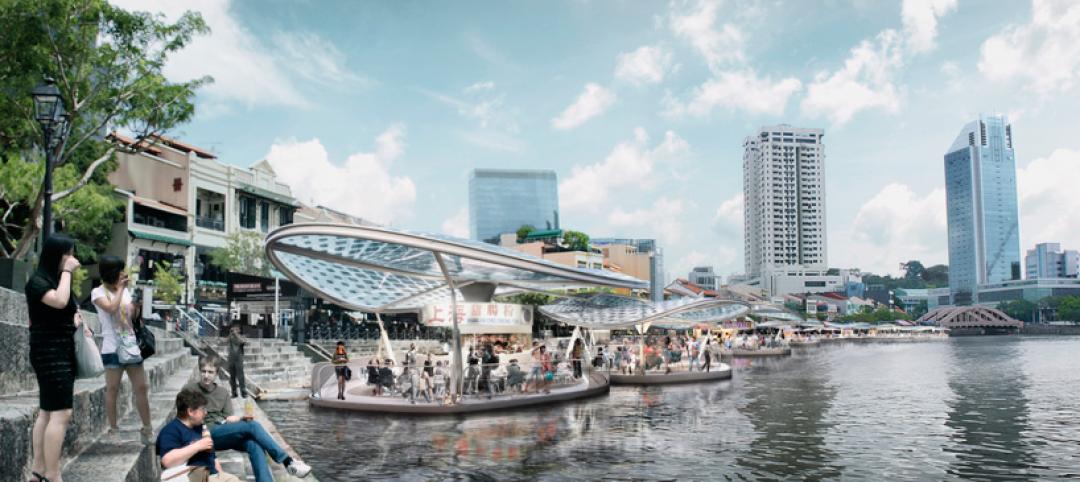The unique relationship between the people of Thailand and elephants dates back at least three centuries. Elephants were used in war and peace, and in rural villages were domesticated to the point where the beasts lived under the same roofs as humans, with their respective lives virtually inextricable.
Deforestation devastated that bond between elephants and the Kui people in northeast Thailand’s Surin Province, depriving both of food and medicinal plants. The province also incurred severe droughts. These events displaced the Kui and elephants to surrounding towns, begging for food or working in elephant camps.
Last month, as part of the government’s “Elephant World” plan that seeks a safe and prosperous reuniting of the Kui and elephants within their homeland, the Surin Provincial Administration Organization completed its Elephant Museum, which sits on a 5,400-sm site and used 480,000 handmade clay bricks in its construction.
Bangkok Project Studio, the museum’s architect, has incorporated handmade bricks for projects before, including the eight-meter-tall walls of the Kantana Film and Animation Institute, which opened in Nakhom Pathom, Thailand, in 2011; and more recently the Elephant Stadium pavilion at Elephant World in Surin, Thailand, completed in 2015.

The complex's curved walls provide visitors with different perspectives, depending on the time of day.
A MESSAGE OF HOPE

Visitors can move freely from one exhibit space to another through entries within the walls.

The Elephant Museum, built by Rattanachart Construction, Ltd., is divided into four sections. The first includes a reception area, exhibition room, library, seminar room, and shops for coffee and gifts. The other three sections feature exhibition spaces that touch on the relationship between the Thai people and elephants; the deforestation that places the elephants’ survival at risk; and a message of empowerment, where visitors can take pride in their culture.

The museum divides into four sections.
More than 200 elephants live in Surin Province, and the museum’s exhibits reiterate its people’s disapproval of animal cruelty and exploitation, while projecting hope for the future.
The museum, which was completed last month, is within a complex of buildings that includes a play area for elephants, a research center, and educational facilities. Visitors can circulate from one space to another through openings in arched walls. Indoor and outdoor areas allow for a variety of programming.

The museum includes a play area for elephants.
Related Stories
| Jul 17, 2014
A harmful trade-off many U.S. green buildings make
The Urban Green Council addresses a concern that many "green" buildings in the U.S. have: poor insulation.
| Jul 8, 2014
Frank Lloyd Wright's posthumous gas station opens in Buffalo
Eighty-seven years after Frank Lloyd Wright designed an ornamental gas station for the city of Buffalo, the structure has been built and opened to the public—inside an auto museum.
| Jul 8, 2014
Lost in the Museum: Bjarke Ingels' maze will make you look up and around
The maze, located in the National Building Museum, is a precursor to an exhibit showcasing some of BIG's projects. To navigate the maze, people must look up.
| Jul 7, 2014
7 emerging design trends in brick buildings
From wild architectural shapes to unique color blends and pattern arrangements, these projects demonstrate the design possibilities of brick.
| Jul 7, 2014
'Solar orchid' pods will serve as floating restaurants, retail shops in Singapore's harbor [slideshow]
In an attempt to reunite the nation of Singapore with its harbor, SPARK Architects has designed the "solar orchid"—self-contained, solar-powered pods that mimic traditional hawkers.
| Jul 7, 2014
A climate-controlled city is Dubai's newest colossal project
To add to Dubai's already impressive portfolio of world's tallest tower and world's largest natural flower garden, Dubai Holding has plans to build the world's largest climate-controlled city.
| Jul 3, 2014
Gehry edits Canadian skyscraper plan to be 'more Toronto'
After being criticized for the original tower complex, architect Frank Gehry unveils a new design that is more subtle, and "more Toronto."
| Jul 2, 2014
Emerging trends in commercial flooring
Rectangular tiles, digital graphic applications, the resurgence of terrazzo, and product transparency headline today’s commercial flooring trends.
| Jul 1, 2014
Peter Zumthor's LA art museum plan modified with bridge-like section across main thoroughfare
After his design drew concerns about potential damage to LA's La Brea Tar Pits, Peter Zumthor has dramatically revised his concept for the Los Angeles Museum of Art.
| Jul 1, 2014
Zaha Hadid's flowing Heydar Aliyev Center named Design of the Year for 2014
The Design Museum's Design of the Year award has been awarded to Zaha Hadid's Heydar Aliyev Center. Hadid is not only the first woman to win the top prize, but the center is the first architectural project to win the overall competition.

















